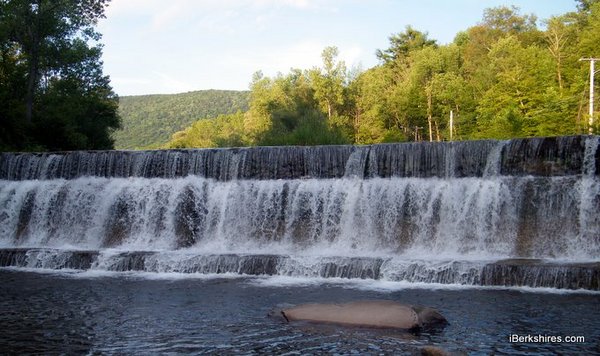
Clarksburg OKs Funds for Dam Removal
 The Briggsville Dam this spring; the water dropped to a trickle over the summer and the silt and rocks behind it have created an island that we hear people have taken to picnicking on. |
The Selectmen had been prepared to defend the transfer of $87,000 from the stabilization account to complete the financing package for the removal of the deteriorating concrete dam. But the nearly doubling of a National Resources Conservation Services grant meant the town's money may not even be used.
Some two dozen people attended the special town meeting at the elementary school. Selectmen Chairwoman Debra Lefave amended the motion from $87,000 from the stabilization fund to $20,000 from the same account to be placed in a separate fund for no more than two years. The money would be spent at the discretion of the Selectmen in relation to work or monitoring on the dam.
The article passed swiftly, 20-1, well above the two-thirds vote needed, and the meeting wrapped up in 7 minutes.
Selectmen Carl McKinney credited Town Administrator Michael Canales with the nearly unanimous approval.
"He shook every tree looking for money and did not give up," said McKinney. "Without him, this would have been a lot less palatable."
The town and dam owner Cascade School Supplies have been working with state, federal and nonprofit agencies to remove the decades-old dam that once powered the Strong-Hewat Woolen Mill. Work had been expected to start this summer but the funding came up short of the $700,000 estimated cost.
In addition to the $302,500 grant from NRCS' Wildlife Habitat Incentive Program, the bid for removal came in slightly lower than expected at $385,000; with monitoring and contingency, the expected cost is $505,258. Some $171,000 has already been spent on design and permitting.
Nick Wildman, priority projects coordinator of the state's Division of Ecological Restoration, said the work could start by the end of the month. "This is a fine time to do it," he said because spring would be problematic. If the work doesn't start this fall, it would have to wait until next summer.
Representatives for the state's Department of Wildlife and Fisheries will be on hand to monitor and remove fish (such as the longnose sucker) as necessary during the dredging and dam removal. More on what will happen can be found here.
McKinney said this year's tax rate would not be affected, in response to a question. He could not guarantee the transfer wouldn't affect a future budget and it could, in fact, be used to help lower the tax rate if not spent in two years.
Cascade School Supplies, which is putting $30,000 toward the project, is glad to see the dam go. It's been designated a high priority for removal by the state and considered a liability for the company that's moved into the former woolen mill.
Todd E. Shafer, vice president of Cascade, said the outside funding made it possible to remove it. As for restoring the dam, he said there just wasn't the funding available — just stabilizing the deteriorated structure was estimated at $600,000.
"We sell pencils for a living," said Shafer. "We don't know anything about hydro."















